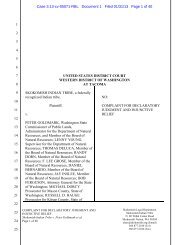Appellant Brief - Turtle Talk
Appellant Brief - Turtle Talk
Appellant Brief - Turtle Talk
Create successful ePaper yourself
Turn your PDF publications into a flip-book with our unique Google optimized e-Paper software.
“such as this one.” Recall, however, that the Strate Court only concluded that the<br />
right-of-way in that case was the equivalent of alienated Indian land after<br />
examining the facts specific to that case. Footnote 14 does not foreclose factual<br />
analysis.<br />
The most sensible reading of footnote 14 then is that it allows a nonmember<br />
to proceed directly to federal court for a preliminary review of any particular right-<br />
of-way and the surrounding circumstances. If it is a clearcut case, as in Strate,<br />
exhaustion would not be required. If it is not clear that a right-of-way is “land<br />
covered by Montana’s main rule,” the federal court should stay or dismiss an<br />
action until the tribal court has had a chance to determine its own jurisdiction,<br />
including development of a thorough record. 6<br />
3. Other Courts Have Engaged in Fact-Specific Analysis<br />
Under Strate.<br />
Consistent with the Tribal Court’s interpretation of Strate, including<br />
footnote 14, other courts have looked at the nature of a right-of-way before making<br />
rulings under Strate. That exercise would be wholly unnecessary were the District<br />
Court correct that any surrender of control by a tribe also surrenders jurisdiction.<br />
6 The proper procedure in tribal exhaustion cases, including whether the federal<br />
court acts in a trial or appellate capacity, is far from clear in the cases. Much of the<br />
briefing in the District Court addressed the ramifications of that lack of clarity.<br />
18

















